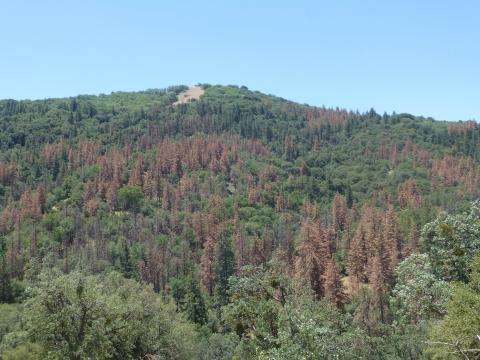A new U.S. Forest Service report, edited in partnership with Duke University, projects that drought will have far-reaching impacts on U.S. forests and grasslands in coming decades.
"While the effects have been most pronounced in the West, this new assessment finds virtually all U.S. forests and grasslands are now experiencing some degree of change and are vulnerable to future declines," said James S. Clark, Nicholas Professor of Environmental Science at Duke, who was one of the report's lead editors.
Released this week, the report, "Effects of Drought on Forests and Rangelands in the United States: A Comprehensive Science Synthesis," provides a national overview of peer-reviewed scientific research on the impacts of drought on U.S. forests and rangelands. It is intended to help the Forest Service better manage forests and grasslands impacted by climate change.
Seventy-seven scientists from the Forest Service, other federal agencies, research institutions and universities across the United States contributed to the new assessment.
"Our forests and rangelands are national treasures, and because they are threatened, we are threatened," said Agriculture Secretary Tom Vilsack. "This report confirms what we are seeing, that every region of the country is impacted by the direct and indirect effects of drought conditions and volatile weather patterns. Sixty million Americans rely on drinking water that originates on our 193 million acres of national forest and grasslands. They support 200,000 jobs and contribute over $13 billion to local economies every year."
The report establishes a comprehensive baseline of available data that land managers can use to test how well their efforts to improve drought resilience and adaptation practices are working nationwide, Clark said.
Major findings include:
- Drought projections suggest that some regions of the U.S. will become drier and that most will have more extreme variations in precipitation.
- Even if current drought patterns remained unchanged, warmer temperatures will amplify drought effects.
- Drought and warmer temperatures may increase risks of large-scale insect outbreaks and larger wildfires, especially in the western U.S.
- Drought and warmer temperature may accelerate tree and shrub death, changing habitats and ecosystems in favor of drought-tolerant species.
- Forest-based products and values – such as timber, water, habitat and recreation opportunities – may be negatively impacted.
- Forest and rangeland managers can mitigate some of these impacts and build resiliency in forests through appropriate management actions.
Since 2000, fire seasons have grown longer, and the frequency, size and severity of wildland fires have increased, the report notes.
"Among the many benefits of having this solid baseline data is the improved ability to identify where restoration work can help forests adapt and prosper while minimizing the threat and impact of future wildfires," Vilsack said.
More information: Effects of Drought on Forests and Rangelands in the United States: A Comprehensive Science Synthesis. www.fs.fed.us/sites/default/fi … book-web-1-11-16.pdf
Provided by Duke University























